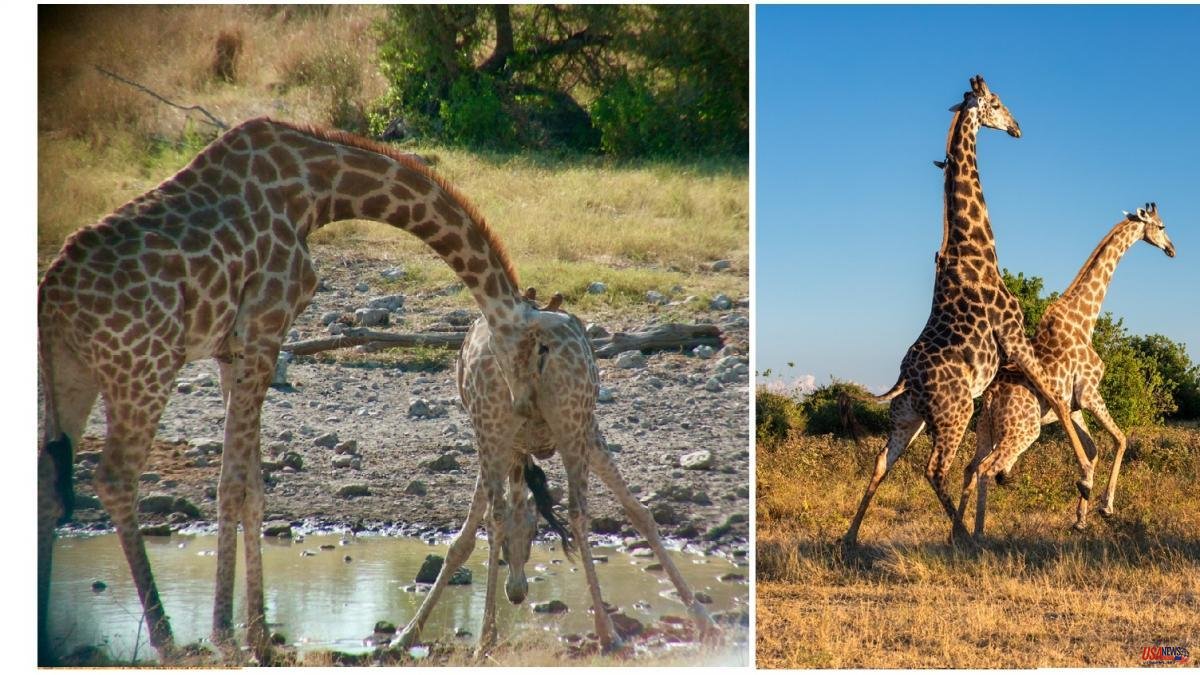Giraffe experts, who there are, have known for years the main characteristics of the sexual life of these artiodactyls (ungulates with even fingers) popularly cataloged as the tallest animals that currently inhabit the earth. However, from what is now known, there are still hidden details in the behavior that facilitates mating and reproduction in these animals that the Romans (at the time of Julius Caesar) believed to be the cross between camels and leopards (for which one of its species has the scientific name of Giraffa camelopardalis).
Lynette A. Hart and Benjamin L. Hart, researchers at the School of Veterinary Medicine at the University of California at Davis (United States), have thoroughly studied a group of specimens of the Angolan giraffe or Namibian giraffe (subspecies named scientist Giraffa giraffa angolensis) and present their results in an article published in the journal Animals (ed. online January 19, 2023) with the title 'Flehmen, osteophagy and other behaviors of giraffes: adaptation of the vomeronasal organ'.
The first two scientific words in the headline need explanation for laymen. Flehmen (from German) means "wrinkle the upper lip" and is a retraction movement of this part of the mouth present in several species of ungulates, felines and many other mammals, which facilitates the arrival of odorants to the vomeronasal organ (or Jacobson's). ), which is located under the upper lip and helps recognition between individuals and sexual identification.
The term osteophagy, on the other hand, is the practice of some animals (especially herbivores) of consuming -chewing and feeding- on the bones of other animals (from corpses or carrion); quite possibly as a supplement due to the lack of phosphate in the usual vegetable diet.
By themselves, these two strange words (flehmen and osteophagy) do not seem to be related to the title of this article, which mainly mentions the sexual behavior of giraffes, but the fact is that the Harts dedicate a good part of their scientific writing precisely to the third part of his highlight: "other behaviors of giraffes", in this case, yes, sexual.
"Giraffes do not have an established breeding season. They do not go into heat, like dogs or cats. They do not make mating calls or provide visual signals of sexual readiness," recalls the information note published by the University of California to present the results of the study of their giraffe experts.
The cues and behaviors that facilitate copulation in giraffes are therefore somewhat different than in many other mammals.
Male giraffes, the Harts explain, cause the females they intend to breed with to urinate in front of them, in a way that makes it easier to detect the hormones that indicate whether the female is currently fertile. The males also, and perhaps because of their long neck, do not smell female urine on the ground.
If the female responds to the male's call, she urinates for about 5 seconds while he sucks up part of the urination, she makes a flehmen and analyzes the hormonal status of the possible partner thanks to her vomeronasal organ, according to the Californian experts.
"The study provides the most accurate understanding yet of how flehmen occurs with giraffe anatomy. While flehmen is common among many animals, including horses and cats, most mammals wait until urine is in the ground to investigate.
"The giraffe, however, is not built to facilitate such explorations," the University of California details in other words.
"They seem not to want to take the risk of lowering their heads to the ground and ask the female to urinate to facilitate verification before attempting copulation," says the study's lead author.
Lynette and Benjamin Hart witnessed this behavior on multiple research trips to Namibia's Etosha National Park. Benjamin Hart had studied how flehmen behavior worked within the anatomy of other animals, including goats. During their travels to East Africa, the Harts suspected a similar process was occurring for giraffes.
The Harts also describe in the study little-known giraffe behaviors such as osteophagy, which appears to be more common in this subspecies than previously believed, and a possible response of grief or sadness at the death of other giraffes.
Previous studies noted that osteophagy, or bone chewing, was unusual for giraffes. But the Harts observed many instances of giraffes searching for and chewing on bones, sometimes stuffing them into their mouths for hours.













